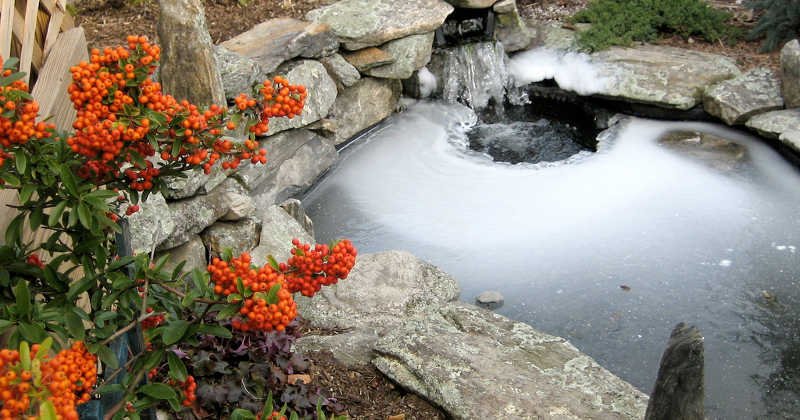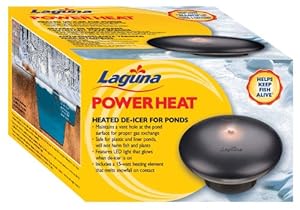In the winter when cold weather chills the pond water, koi and goldfish must adapt to survive in this less than friendly environment. Being “cold-blooded”, their body temperature falls along with the water temperature. This decreases their breathing rate and energy needs.

(source)
If you can see through the ice, koi and goldfish either swim very slowly or don’t move at all in cold water. If your pond is home to frogs, they’ll burrow into the mud and leaves at the bottom and hibernate there over the winter. Amphibians able to do this by breathing through their skin.
However, if the pond’s surface is sealed with a layer or ice, especially with a cover of snow, it can cause “winterkill,” resulting in the death of fish, frogs, and other aquatic life. The good news is that a pond de-icer will prevent winterkill from occurring. But first, let’s take a closer look at what happens under the ice during the winter.
What happens under the ice during the winter?
During the cloudy, cold winter, oxygen (O2) produced from photosynthesis by aquatic plants and algae is greatly reduced. Our submerged and floating plants wither and die in the autumn.
Even though we don’t like algae, these tiny plants contribute a lot of oxygen to the pond water. Algae die back in the winter. Some algae survive the cold and continue to produce oxygen but at a reduced rate.
Winterkill happens when there is a significant reduction in oxygen during a long period of ice cover. As long as there is a small opening in the ice, oxygen levels remain high enough for pond life to survive. But when ice forms a solid seal all around the pond edge, the sole supply of oxygen becomes the tiny amount produced by the few remaining algae and plants.
But each day the pond fish use slightly more oxygen than is produced. Our koi ponds and water gardens have a lot more “pounds of fish” per gallon than natural lakes and ponds. The more fish we have, the greater the oxygen demand.
This happens quite rapidly when the pond is covered with snow, blocking out the sunlight. Eventually the oxygen runs out! But there are other dangers related to ice cover.
Another important factor is the amount of decaying sludge, plant stems and leaves, algae and other organic matter that collects on the bottom of the pond. The decay process consumes oxygen. To make matters unhealthier, decomposition of this organic matter releases carbon dioxide (CO2) and poisonous hydrogen sulfide (rotten egg gas).
The decay process is natural and recycles nutrients and minerals all year long. The problem is in winter when the ice cover prevents these gases from escaping the pond water. Fish and pond life can suffer or be killed by a combination of low oxygen and high levels of harmful gasses in the water. This is especially true if the pond has a thick layer of decomposing leaves and sludge.
Having an area free of ice is crucial for koi ponds and water gardens to allow proper gas exchange.
Top-rated Pond De-icers
1. K&H Pet Products Thermo-Pond Heater
The K&H Thermo-Pond Heater is actually a de-icer.
It won’t heat the entire pond but it does stop ice from completely sealing the surface.
The de-icer has a unique, patented design that makes it one of the most popular pond de-icers.
The black floating 12-inch disc absorbs the sun’s heat and radiates it back into the water. But that’s not enough to keep the ice away. Inside the ring is a 100-watt heating element that provides continuous heat. Internal thermostats automatically turn the Thermo-Pond on and off as needed.
The patented technology promises that the pond de-icer will only run as often as needed to maintain a 12-inch hole in the ice. The 100-watt model is rates for ponds up to 1000 gallons. Larger sizes are available.
Pros
- Small size is lightweight and easy to put in and take out of the pond.
- Uses only 100 watts.
- Won't burn the pond liner.
- 12-foot power cord.
- Simple, rugged design.
- One-year warranty.
Cons
- None.
2. TetraPond Pond 300-Watt De-Icer
The TetraPond de-icer is based on a 300-watt heating element imbedded inside a faux floating rock.
An internal thermostat controls the operation of the de-icer. This de-icer is recommended for ponds 300-gallons and larger. It has a 15-foot power cord.
Measures 10-1/2" x 5-1/2".
Pros
- UL-listed.
- 3-year warranty.
- 15-foot power cord.
Cons
- Unattractive fake rock shape.
- Has some reliability issues.
3. Laguna Power Heat Heated De-Icer
The Power Heat de-icer is a fully-encased unit that floats on the pond surface.
The seven-inch diameter disc contains a 315-watt heating element that will keep an opening in the ice when temperatures down as low as 20 degrees Fahrenheit.
The Power Heat features a 15-watt heater embedded into the top of the dome to melt snow and keep the hole exposed to the air.
For added stability, the de-icer can be anchored to the pond bottom using a string or cord attached to the hook underneath the de-icer and weighted to the bottom of the pond by a brick or other suitable weight.
A thermostat prevents overheating if left plugged-in when out of water. It is safe for plastic and liner ponds. A LED light shows that the Power Heat is connected to an active power outlet.
Pros
- Has a LED power indicator.
- Includes a special element to melt snow.
- 22-foot electrical cord.
- Can be anchored if necessary.
Cons
- None.
4. Aquascape 39000 Pond Heater and De-icer
This Aquascape floating pond de-icer is made of durable stainless steel.
The stainless-steel housing contains thermo-sensors that measure water temperature from different locations within the unit.
This smart technology allows for accurate thermostatic control even in freezing conditions.
A blue LED indicates the de-icer is plugged in. A red LED indicates the de-icer is heating. This allows you to visibly see if the unit is working.
The manufacturer rates this 300-watt heating unit for most locations in the US and Canada. The de-icer is safe for plastic and liner ponds. The unit comes with a 22-foot electrical cord with grounded plug.
Pros
- Stainless steel construction prevents corrosion and cracking.
- Integrated thermostat saves electricity.
- Built-in LED light indicates de-icer status.
- 22-feet power cord.
- 3-year warranty.
Cons
- None.
How to protect your pond from winterkill
Never use physical force to break an opening in the ice. Fish are very sensitive to vibrations and hitting the ice with a hammer or axe can stun or severely injure fish.
Koi enthusiasts and breeders of exotic tropical water plants sometimes use pond heaters to protect their fish and plants. Pond heaters are designed to heat all the pond water to 52 degrees or warmer, so tropical plants remain alive and koi continue to feed and grow.
This is a very expensive proposition and not suitable or necessary for the backyard koi enthusiast or water gardener. Fortunately, thermostatically controlled de-icers are available to help our fish survive the winter months.
Pond de-icers are sometimes referred to as “heaters” by retailers, so don’t be surprised when you see the product descriptions. Pond deicers are easy to install and use. Many are energy-efficient and aren’t expensive to operate, even over a long, cold winter.
Take a look at these pond de-icer FAQs to learn how they work.
Pond de-icer FAQs
Can I heat my pond with a de-icer?
No. A pond de-icer is not designed to keep the pond water warm. De-icers create a small, localized area of warmth right around the heating unit.
The idea is keep a small portion of the frozen pond open for gas exchange, allowing for oxygen to enter the water and harmful gasses to diffuse out of the pond.
Will a de-icer keep my fish active all winter?
Since a de-icer does not heat the pond water, fish activity will be related to the water temperature. The colder the water, the more the fish slip into hibernation mode.
How large of a hole in the ice do I need?
Experience shows that only a very small portion of a backyard pond needs to be open. Most de-icers maintain a hole about 10 inch in diameter. A lot depends on the weather.
If your winters are mild with occasional periods of ice a pond heater may create a large area of open water. Under hard-freeze conditions a de-icer may only keep a small portion of the pond thawed.
Do de-icers use a lot of electricity?
No. De-icers use small heating elements that consume 100-500 watts of electricity. A thermostat turns the heating element on and off as needed.
The power consumption is very low since only a small area of the pond needs to be ice-free.
My Pick
All of these pond de-icers will keep your pond safe over the long winter months. The main differences are the size of the heating units inside the de-icer.
The K&K Thermo-Pond heater is the lowest-rated (100 watts) heating capacity but is a very popular de-icer. It is lightweight and has a long power cord. If you need more heating power due to extremely cold climates, a higher wattage de-ice is probably beneficial.
The Laguna Power Heat boasts 315 watts and a LED light that indicates that the heater is plugged in. It also has a dome heater to keep snow from covering the de-icer and open hole in the pond.



